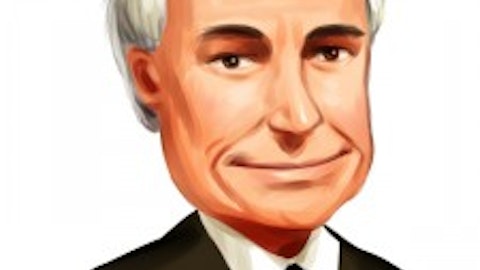IAC Inc. (NASDAQ:IAC) Q4 2023 Earnings Call Transcript February 14, 2024
IAC Inc. isn’t one of the 30 most popular stocks among hedge funds at the end of the third quarter (see the details here).
Operator: Good morning, and welcome to the IAC and Angi Fourth Quarter 2023 Earnings Conference Call. All participants will be in listen only mode. [Operator Instructions] After today’s remarks, there will be an opportunity to ask questions. Please also note this event is being recorded. I would now like to turn the conference over to Christopher Halpin, CFO and COO of IAC. Please go ahead.
Christopher Halpin: Thank you. Good morning, everyone. Christopher Halpin here, and welcome to the IAC and Angi Inc., fourth quarter earnings call. Joining me today is Joey Levin CEO of IAC, and CEO and Chairman of Angi Inc. Similar to last quarter, supplemental to our quarterly earnings releases, IAC has also published its quarterly shareholder letter, which is currently available on the Investor Relations section of IAC’s website. We will not be reading the shareholder letter on this call. I’ll shortly turn the call over to Joey to make a few brief introductory remarks, and we’ll then open it up to Q&A. Before we get to that, I’d like to remind you that during this presentation we may discuss our outlook and future performance.
These forward-looking statements typically may be preceded by words such as, we expect, we believe, we anticipate or similar statements. These forward-looking views are subject to risks and uncertainties and our actual results could differ materially from the views expressed today. Some of these risks have been set forth in IAC’s and Angi Inc.’s fourth quarter earnings releases and our respective filings with the SEC. We’ll also discuss certain non-GAAP measures, which, as a reminder, include adjusted EBITDA, which we’ll refer to today as EBITDA for simplicity during the call. I’ll also refer you to our earnings release, the IAC shareholder letter, our public filings with the SEC and again to the Investor Relations section of our respective websites for all comparable GAAP measures and full reconciliations for all material non-GAAP measures.

Now, I’ll turn it over to Joey.
Joey Levin: Good morning. Happy Valentine’s Day. I think I’ve done this call on Valentine’s Day many times over the years, so I’m not going to try another bad Valentine’s joke. Hopefully, you’ve all had a chance to read the letter and review the numbers. I want to start again by giving a very big thank you to all the teams across the businesses at IAC and the corporate folks at IAC, at Angi, Dotdash Meredith, MGM and Turo for making our job much easier this quarter. It’s a heck of a lot easier to write these letters and get on these calls when the news is good. So thanks to everyone for making that happen. And it wasn’t just one quarter. 2023 was a year of real hard work, changing our mindset, getting things done on behalf of our customers in the long-term health of our businesses.
And it really paid off in this last quarter. So thank you all. Hopefully, some of you are listening in this Valentine’s morning. And that’s why Chris and I have a spring in our step this morning. It’s not just Valentine’s Day, that’s performance. So, Drew, let’s get the questions. Thank you.
See also Top 20 Chocolate Companies in the World by Revenue and 30 Unhappiest Countries In The World.
Q&A Session
Follow Iac Inc. (NASDAQ:IAC)
Follow Iac Inc. (NASDAQ:IAC)
Operator: We will now begin the question-and-answer session. [Operator Instructions] The first question comes from Cory Carpenter with JP Morgan. Please go ahead.
Cory Carpenter: Thank you. I had two on Angi, maybe Joey first, could you just expand on the trends you saw in the fourth quarter and what led to the upside relative to your guide for Angi? And then secondly, would be helpful to hear your expectations on the revenue side for Angi this year and what’s embedded within your ’24 profit outlook? Thank you.
Joey Levin: Sure. Thanks, Cory. I’ll take the first and Chris will do the second. The biggest thing that we’ve underestimated, and we’ve really continually underestimated this is, notwithstanding talking about it a lot, is service professional retention and the progress there has been tremendous. It’s the result of a lot of things that we’ve done to drive satisfaction. First of all, targeting better service professionals with sales, giving them more compelling, committed offers, giving them a chance of success. Some things we’ve done on the demand side to improve the mix of demand to, to help their win rates, and that retention has continued to move up. And I think we haven’t gotten as good at sort of modeling that upside and we look at it conservatively.
But as that comes through, it makes each individual transaction for us, unit economics more profitable because we have more service professionals active in engaging with service requests. Related to that is, things like bad debt. We’ve been outperforming on bad debt all year because again, we have happier service professionals. The other thing is the margins in our paid marketing, and we’ve been expanding the margins in our paid marketing through, I think, a combination of smarter spend and some conversion improvements and obviously that’s good for margins. And all year 2023 relative to 2022, we’ve been much tighter on fixed costs and costs in general. And so the combination of those things all came through on profit. And I think a lot of those trends are — almost all of what I just said, I think is durable, sustainable for the future.
So that’s, I think, a good thing for Angi’s margins.
Christopher Halpin: Yeah. Thanks, Corey. In terms of outlook for ’24, we expect the revenue trend to improve over the course of the year from the declines you saw in Q4. But we also think it’s important to retain flexibility in terms of revenue growth in order to do what we need to keep improving the foundation for user experiences, both on the pro side and the homeowner side. What does that mean in Q1, we’d expect the decline in revenue year-over-year to be roughly the same rate as we experienced in aggregate in Q4 of ’23, up maybe a little bit better in Q1. The bulk of the actions that we took last year to eliminate low margin and low quality revenues really showed up in Q2 of last year. So the comps do get easier. Q1 will be the most challenging.
We expect year-over-year revenue declines throughout ’24, but expect that percentage to narrow as we lap the easier comps and also the fruits of some of the actions that Joey talked about and we’re taking on demand side begin to show. But we’re not forecasting return to revenue growth this year. On profitability, we expect to sustain the 10% plus EBITDA margins we demonstrated in this last quarter. When you normalize for the insurance settlement, we expect Q1 adjusted EBITDA to be up slightly year-over-year, despite the lower revenue over what we generated, to be up over what we generated in Q1of ’23. And we’d forecast 10% to 12% adjusted EBITDA margins each quarter in ‘24. And that’s how you get to the $120 million to $150 million of adjusted EBITDA in our guidance.
Thank you, next question operator.
Operator: The next question comes from John Blackledge with TD Cowen. Please go ahead.
John Blackledge: Great, Thanks. Two questions. First, on Dotdash DDM digital, the ad revenue growth acceleration was better than expected. Can you talk about the key drivers of the acceleration? And then, for ’24, how should we think about the trajectory of DDM digital ad revenue growth and EBITDA for the segment, just given the acceleration and EBITDA upside in 4Q? And then second question on free cash flow in ’24, it looks like IAC will return to kind of be a big free cash flow generator. Any way to kind of frame free cash flow conversion of EBITDA in ‘24? Thank you.
Joey Levin: Yeah. I’ll start, and then I’ll turn it to Chris, again. Digital revenue growth was really all the key factors, traffic, meaning volume; price, meaning ad sales rate; premium sales monetization. And that was, I think a big win for the business and a big change in direction that we’re pretty proud of. You can see that core sessions, which is over 80% of traffic grew 10% and continued to accelerate. I mean, that’s a really nice trend to see. And the rate, if you just look at revenue per session up nicely, too. Premium sales is about two-thirds of our ad revenue and that was solid really, for the first time since the ad recession started in Q2 of ’22. That’s a credit to, again, performance of our product, but also the combined sales force just working well together and programmatic was excellent.
We mentioned this in the letter, but we think our CPMs are growing more in the market and that’s a combination of, again, technology and performance. And performance marketing, which has been a real source of strength throughout the year is, continues to do well. And this one thing, I want to add on performance marketing is in this area, performance where we’re delivering performance marketing. The product that we’re creating is something that our users really want from us. Users really want to hear from food and wine on what is the best air fryer and we deliver that. We deliver that unbiased. We deliver that with real work put into the product. And then that also happens to monetize well because it delivers performance marketing. But you do that across all the Dotdash Meredith brands and there’s a huge opportunity there.
And I think we’ve done a really good job, that was sort of central to the acquisition thesis with Meredith. And I think we’ve done a real good job executing against that, and it’s shown up a lot over the course of 2023.
Christopher Halpin: Thanks, Joey. For ’24, John, how we would think about overall trends in phasing is, we expect digital revenue to continue to grow for all the factors that Joey articulated. While print revenues will continue to decline, digital traffic and monetization have continued their momentum into the first quarter of ’24. The ad market is fine, not great, not bad. And we think we’re taking share. We definitely think we’re taking share on traffic and also on some on revenue per session. So for the year, we’d expect 10% plus digital growth across ’24. Conversely, print revenues declined 12% in Q4 of ’23, and we’d expect similar declines next year, especially in the first half. May slow down a bit in terms of decline in the second half.
When you look at our profitability, our guidance is $280 million to $300 million in adjusted EBITDA across all of Dotdash for the year versus $267 million in adjusted EBITDA in ’23. But there’s some layers to that. It implies 5% to 10% EBITDA growth. But what is really happening is strong growth and margin expansion continuing in digital and then offset by some profitability declines, which is what we’d expect. We’ve said our aim is to have our print EBITDA offset our corporate segment. But in ’23, print actually significantly outperformed corporate by $24 million. In this current fiscal year, we’d expect that to be pretty much equal. So really all of that $280 million to $300 million of adjusted EBITDA guidance for this coming year is digital EBITDA, that pattern will be pronounced in the first quarter.
We expect digital EBITDA to grow 40% plus year-over-year in the quarter, Print will be roughly breakeven on adjusted EBITDA basis in the corner, it’s seasonally the smallest revenue. And also we’ve got some expense increases like postage flowing through. And then, finally, corporate expense should be roughly equal in the $9 million range to what we saw in Q4. For those looking year-over-year, just remember we had the $44 million lease impairment that flowed through in Q1 of ’23 in corporate. When you roll all that up, adjusted EBITDA in aggregate will grow in Q1, but strong digital growth will be masked by declines in print. And then for the year, digital revenue should continue, as we said, at 10 plus growth, you’ll see that margin scale, the incremental margins and the seasonal uplift, and we feel good about the momentum trend across the business.
Your last question on free cash flow conversion across all of IAC, if I’m getting that right, we felt good about getting back to free cash flow generation last year. It’s been a major point of focus by Joey, to all of us and we expect our conversion to only improve in ’24 due to a couple of factors. One is aggregate EBITDA, as evidenced in our guidance should be up even with the sale of Mosaic, led by DDM and Angi. CapEx should stay in the $70 million range. Last year in that 15% conversion, that that you referenced, we purchased the land under our headquarters for $80 million, that’s obviously not recurring. Interest, net interest expense should only improve with higher yield for the full year than we had in our cash last year, and then we’ve got $1.4 billion of NOLs, which is a substantial tax yield.
So roll that all up and we would expect 50% plus of adjusted EBITDA to convert into free cash flow in ’24 and look forward to continue to improve going forward. Thank you, operator. Next question.
Operator: The next question comes from Brian Fitzgerald with Wells Fargo. Please go ahead.
Brian Fitzgerald: Thanks. On Angi, thanks again for the comments on the shape of the year there. We wanted to ask more specifically on consumer demand. I think the service request decline was one of the steepest we’ve seen, since you’ve been prioritizing quality and profitability. Are you closing in on getting the customer acquisition engine where you want it, and beginning to scale that back up? Do you have line of sight for when that hits sometime in ’24?
Joey Levin: Sure, Brian. I would say not yet in terms of line of sight, we are making real progress. We’re, and I’ll also just point out and I think we said this in the letter, monetized transactions are doing better than, than the trend line and service request because we are doing a better job with stuff that monetize as well and matching that better with service professionals. So that service request decline, while steep is not as steep to the business as it appears. But maybe it’s helpful to talk about some of the things that we’re working on and how those impact the business. I mentioned before, and I’ll keep mentioning just because it’s so important to the business, the service professional retention trends. And relatedly, the improvement in monetized transactions per SR.




